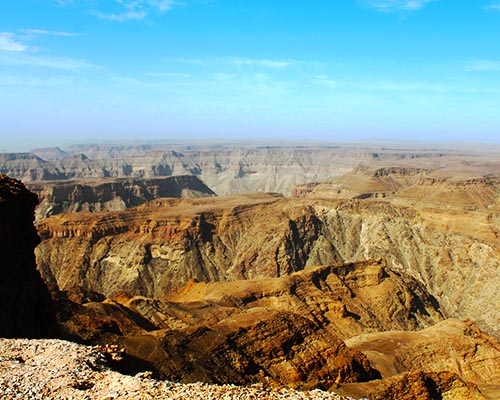The Fish River Canyon
Visiting the Fish River Canyon: What to Know
Discover the breathtaking beauty of Fish River Canyon with awe-inspiring vistas

Located in southern Namibia, the Fish River Canyon is one of Africa’s most awe-inspiring natural attractions. Stretching approximately 160 kilometers in length, up to 27 kilometers wide, and plunging to depths of 550 meters, it is the largest canyon in Africa and the second-largest in the world after the Grand Canyon in the United States. This dramatic landscape, carved over hundreds of millions of years, draws visitors from around the globe for its geological significance, hiking opportunities, and stunning views.
Geological History. The formation of the Fish River Canyon began over 500 million years ago with tectonic activity and glacial movement. The Fish River, which runs seasonally through the canyon, further deepened the gorge through erosion. Today, the canyon exposes layers of rock that offer insight into the Earth’s geological past, making it a site of interest for geologists and nature enthusiasts alike.
Hiking and Activities. One of the most popular activities in the Fish River Canyon is the Fish River Canyon Hike, a challenging multi-day trek that covers about 85 kilometers from Hobas to Ai-Ais. This hike is typically undertaken between May and September when temperatures are milder, and the river may still contain pools of water. Hikers must be self-sufficient and carry their own supplies, as there are no facilities along the route. A medical certificate and hiking permit are required to complete the trail. For those not taking on the full hike, the Hobas Viewpoint offers panoramic vistas of the canyon's vast expanse and is easily accessible by car. Short walks along the rim and guided day tours are also available for those seeking a more relaxed way to experience the canyon.
Flora and Fauna. Despite the harsh desert environment, the Fish River Canyon supports a surprising variety of plant and animal life. Adapted to arid conditions, flora such as quiver trees, succulents, and camelthorn trees dot the rocky landscape. Wildlife includes mountain zebras, kudu, baboons, and rock hyraxes. Birdlife is abundant, with species such as black eagles and rock kestrels commonly seen soaring above the cliffs.
Getting There. The Fish River Canyon is located within the ǀAi-ǀAis/Richtersveld Transfrontier Park, a cross-border conservation area shared between Namibia and South Africa. The nearest entry point is Hobas, which serves as the main gateway to the canyon. Visitors can access Hobas via the B1 and C12 roads, with the nearest towns being Keetmanshoop and Karasburg. Accommodation options range from campsites and basic chalets at Hobas and Ai-Ais to very good nearby lodges offering comfortable stays and guided tours. Ai-Ais, located at the southern end of the canyon, is also known for its hot springs and spa facilities, making it a relaxing stop after a strenuous hike.
Travel Tips Best time to visit: May to September offers cooler temperatures and optimal hiking conditions. Permits: Required for hiking the canyon; available through Namibia Wildlife Resorts (NWR). Climate: Daytime temperatures can be hot even in winter; nights can be very cold. Safety: Mobile signal is limited—travel prepared and inform someone of your itinerary.
Conclusion. The Fish River Canyon is a destination of raw beauty, geological intrigue, and outdoor adventure. Whether you’re an avid hiker or a casual traveler seeking stunning views, the canyon offers a memorable experience amid Namibia’s rugged southern landscapes.
Please contact us and we will arrange a dream safari for you to experience amazing Namibia
Other interesting articles about Namibia
